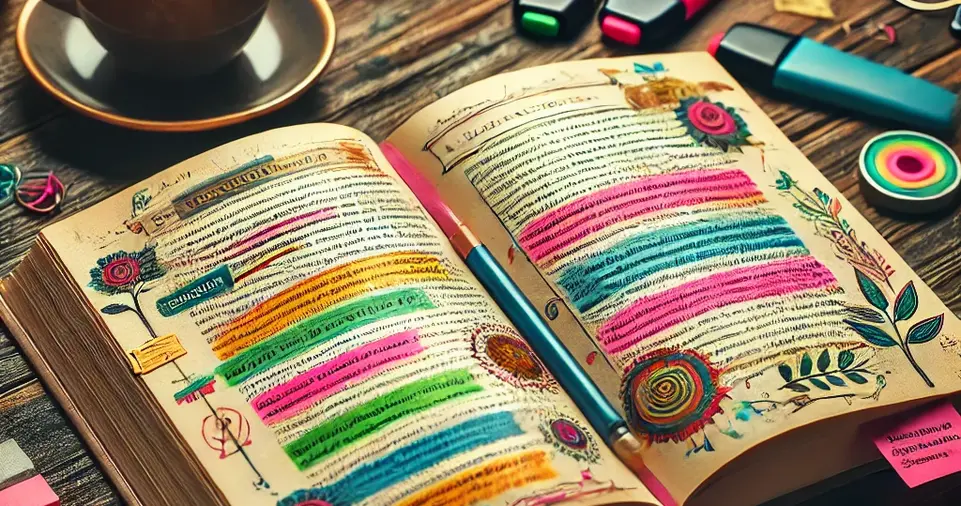Annotating Books: Annotation is not just a reading tool; it’s an art that can transform how you interact with books.
It elevates reading from a passive activity to an active conversation with the text. Whether you’re reading to deepen your understanding, improve retention, or simply to savor your favorite novels, annotating can make every reading session more rewarding.
For students, annotations are a critical component of effective study habits, enabling them to extract key insights and analyze themes.
For professionals, annotating technical or non-fiction works can aid in extracting actionable knowledge.
And for passionate readers, annotations help capture emotions, record favorite quotes, and identify recurring ideas.
Despite its many benefits, annotation often feels intimidating. Many worry about defacing their books or fear they won’t annotate “correctly.”
But the beauty of annotation lies in its flexibility. It’s a personal process with no strict rules, allowing you to tailor it to your needs and preferences.
This guide offers a step-by-step approach to help you master annotation, covering why it’s essential, tools to use, methods for annotating different types of books, and tips to refine your skills.
Let’s unlock the power of annotation and turn every book into a deeply personal, engaging experience.
Why Annotating Books is Essential
Annotation is more than a simple act of writing in books; it’s a gateway to deeper understanding and connection with the text.
Every mark, note, or highlight you make is a step toward engaging more profoundly with the author’s ideas.
Annotating helps you break down complex thoughts, identify recurring patterns, and uncover hidden layers in the narrative or argument.
For example, in literature, you might discover subtle symbols or themes that would otherwise go unnoticed.
In non-fiction, you might clarify intricate concepts by summarizing them in your own words.
Beyond comprehension, annotation is an excellent memory aid. When you write something down—whether it’s a summary of a paragraph, a question, or a personal reaction—you create a stronger cognitive link to that information.
This makes recalling the details easier, especially during exams or discussions. Additionally, annotating encourages active reading.
Instead of passively absorbing the material, you’re questioning, analyzing, and critiquing it, which keeps your mind engaged.
Moreover, annotations act as a personalized roadmap when you revisit a book. Years later, you can flip through your notes and instantly recall what moved you, challenged you, or inspired you.
This makes annotated books invaluable resources that grow richer over time, providing a snapshot of your thoughts and growth.
Essential Tools for Effective Annotation
The right tools can make a world of difference in your annotation process. Selecting high-quality, comfortable-to-use supplies ensures you stay motivated and enjoy the experience.
Start with the basics: highlighters, pens, pencils, and sticky notes. Highlighters are great for emphasizing key points, but overusing them can make the text look cluttered, so it’s wise to use them sparingly.
Pens and pencils are versatile tools for writing marginal notes or underlining important phrases. Pencils, in particular, are ideal for beginners who might want to erase and revise their notes.
Sticky notes and tabs are invaluable for those who prefer not to write directly in their books.
They’re perfect for jotting down extended thoughts or marking specific pages. Some readers even color-code sticky notes to align with their annotation system.
Page flags are another popular choice; they allow you to mark sections without leaving any marks on the page itself.
If you’re a heavy annotator, consider investing in specialty tools like archival-quality pens that don’t bleed through pages or journals dedicated to note-taking.
For digital books, apps like Kindle Notes or Notability offer annotation features, including highlighting, commenting, and even collaborative annotations.
With the right tools, the process becomes smoother, more enjoyable, and highly effective.
Creating an Annotation System

Developing a structured annotation system is crucial for keeping your notes organized and meaningful.
An effective system ensures that you can quickly locate specific insights, themes, or quotes when reviewing your book.
A great starting point is to decide on a color-coding scheme. Assign colors to different types of content: for example, yellow for important ideas, blue for themes, green for unfamiliar terms, and pink for personal reactions.
This approach creates a visual map of the text’s contents, making it easy to navigate later.
Another strategy involves symbols and abbreviations. For instance, an asterisk (*) can mark particularly important passages, while a question mark (?) can indicate areas of confusion or debate.
Arrows can connect related ideas across pages or chapters, helping you trace themes or arguments throughout the book.
Marginal notes are an essential component of any annotation system. These concise comments summarize paragraphs, clarify difficult passages, or record your reactions.
To ensure your notes remain accessible, consider writing them in a way that would make sense even years later when you revisit the book.
Consistency is key; sticking to the same system for multiple books ensures that your annotations remain intuitive and easy to understand.
ALSO READ: How to Keep Track of the Books You Read
How to Annotate Fiction Books
Fiction offers an incredible canvas for exploration, emotion, and analysis, and annotating it can deepen your appreciation of the story.
Start by focusing on the characters. Jot down their traits, relationships, and key decisions.
For example, in a complex novel like War and Peace, tracking the relationships between various characters can prevent confusion and enrich your understanding of their development over time.
Themes and symbols are another critical focus in fiction. Many novels weave subtle motifs throughout the narrative, like the green light in The Great Gatsby symbolizing unattainable dreams.
By identifying and tracking these elements, you can uncover the author’s deeper message.
Language is also worth annotating. Authors often use striking metaphors, poetic descriptions, or sharp dialogue that stand out.
Highlighting these passages allows you to revisit the beauty of the prose later and can inspire your own creative writing.
Additionally, capture your emotional reactions to the story. Did a twist surprise you? Did a character’s decision frustrate or move you? Recording these thoughts makes your reading experience more personal and reflective.
Fiction annotations can turn a novel into a cherished companion, brimming with your insights and emotional journey.
How to Annotate Non-Fiction Books

Non-fiction books often aim to inform, persuade, or teach, making them prime candidates for thorough annotation.
Start by identifying the book’s main arguments. These are usually found in topic sentences, introductions, or conclusions. Summarize these arguments in your own words in the margins to ensure clarity.
Pay attention to the supporting evidence the author provides, such as data, examples, or case studies.
Highlight these details and note how they connect to the main argument. For instance, while reading Atomic Habits by James Clear, you might underline examples of habit formation in everyday life and annotate how they apply to your own routines.
Asking questions is a powerful way to engage with non-fiction texts. If you encounter a concept you don’t understand, write down your question in the margins or on a sticky note.
This prompts you to seek answers, whether from further reading or discussion. Conversely, if you disagree with the author, note why and consider counterarguments.
Finally, draw connections between ideas within the book and with external knowledge.
Linking a theory from one chapter to a concept from another helps you see the broader implications of the material.
These connections can also be useful for essays, discussions, or applying the knowledge practically.
Practical Annotation Techniques
Effective annotation techniques can enhance both your reading experience and your comprehension.
Start by focusing on key passages instead of attempting to annotate everything. Look for moments in the text where the author introduces new ideas, provides evidence, or crafts memorable prose.
For instance, in a historical text, you might highlight turning points or critical analyses of events.
Writing summaries is another valuable practice. At the end of each chapter, take a moment to write a brief summary in your own words.
This exercise reinforces your understanding of the material and provides a quick reference for later review.
Summaries are especially useful for lengthy books where details can easily blur together.
Engaging with the text is crucial for active reading. Don’t just passively underline; instead, ask questions, make connections, and offer critiques.
If a particular statement resonates with you, note why. If a character’s actions in a novel frustrate you, write down your thoughts. This dialogue with the text turns reading into an enriching conversation.
Lastly, track recurring ideas. If a motif, theme, or argument keeps reappearing, note how it evolves.
For example, in a novel, a recurring image might symbolize a character’s internal struggles, and tracking its appearances can reveal subtle narrative layers.
Tips for Aesthetic Annotations
For readers who enjoy the visual aspect of annotation, creating aesthetically pleasing notes can be both satisfying and functional.
Start by keeping your handwriting neat and using fine-tip pens or pencils for detailed work. Choose a color palette that complements the book’s tone or matches your mood while reading.
For example, calming pastel colors might suit a reflective novel, while bold, bright colors might work for a high-energy self-help book.
Sticky notes and tabs are excellent tools for adding pops of color without marking the pages permanently.
You can even customize sticky notes with doodles, symbols, or quotes to make them more personal.
Visual learners might benefit from incorporating diagrams, charts, or flowcharts into their annotations, especially for non-fiction books.
Minimalism is another approach to aesthetic annotation. Instead of overloading the pages with marks, focus on a few key highlights and write concise, meaningful notes.
This ensures the book remains readable and the annotations don’t distract from the text.
With a balance of form and function, aesthetic annotations can make your reading experience more enjoyable while enhancing your understanding of the book.
Reviewing and Reflecting on Your Annotations
The process of annotation doesn’t end when you finish the book. To truly benefit, you need to revisit and reflect on your notes.
Start by reviewing the key points you’ve marked, either chapter by chapter or as a whole. This review reinforces your understanding and helps solidify the material in your memory.
Sharing your annotations with others, such as in a book club or study group, can provide new perspectives and deepen your insights.
Explaining your notes and discussing different interpretations of the text can lead to richer conversations.
If you’re a writer, student, or researcher, your annotations can serve as a valuable resource.
Use them to support your arguments, draw connections, or provide evidence in essays and reports.
For avid readers, reflecting on annotations can inspire future reads or help you track your growth as a reader.
ALSO READ: How to Read Multiple Books at Once Without Feeling Overwhelmed
Final Thoughts
Annotation is a powerful skill that grows with practice. It’s not about perfection but about creating a personal and meaningful connection with the text.
Whether you’re delving into classic literature, exploring groundbreaking non-fiction, or simply enjoying a page-turner, annotating can transform your reading experience.
Start small and experiment with different techniques. Over time, you’ll discover what works best for you, making every book an opportunity for growth and discovery.
By mastering the art of annotation, you’ll unlock the deeper layers of every book and create a library of knowledge that reflects your unique journey as a reader.

